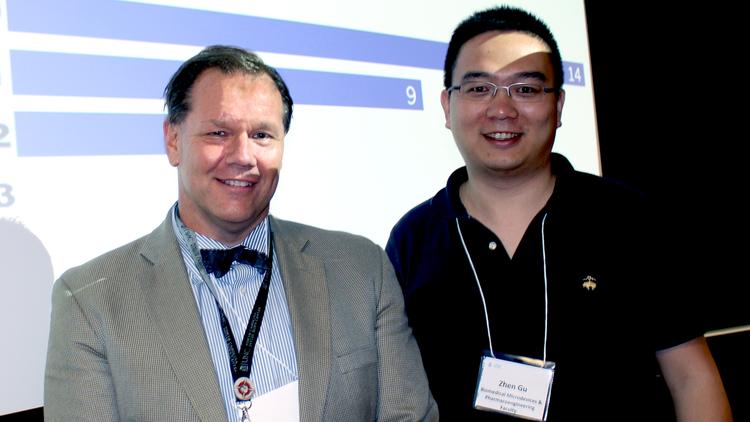
The UNC Lineberger Comprehensive Cancer Center played matchmaker hosted a scientific speed-dating event to match surgeons with engineers based on mutual interests in solving real-world medical problems.
“Everybody does their job, and everybody is busy in their careers,” says Dr. Jen Jen Yeh, the vice chair for research in the UNC School of Medicine Department of Surgery who helped organize the event. By forcing short sessions in which an engineer explains a new product and a surgeon explains a real-world problem, Yeh and her cohorts hoped to find a match.
As it turns out, they found matches; ones that likely would not have happened without the speed-date function.
At the end of the event, teams pitched their ideas for funding. UNC Lineberger contributed $40,000 thanks to the support of the University Cancer Research Fund, a fund created by the N.C. General Assembly for cancer research. The Joint UNC/NC State Department of Biomedical Engineering and UNC School of Medicine Department of Surgery also contributed additional funding.
The top match pitched the concept of a bandage that would release pain medication when stimulated by movement. The concept was pitched by Dr. Bruce Cairns, director of the N.C. Jaycee Burn Center, and Zhen Gu, a professor in the Joint UNC/N.C. State Department of Biomedical Engineering.
“This idea is about being able to deliver a drug to the wound in a reliable way,” Cairns said of the bandage concept. “When a patient gets burned, if they’re laying still, it doesn’t always hurt. What we have proposed is a motion-activated drug release.”
Gu was co-senior author of a study published recently in the Proceedings of the National Academy of Sciences that detailed findings of research into a new, painless smart insulin patch. Their study found that the patch could lower blood glucose in a mouse model of type 1 diabetes for up to nine hours. Gu didn’t initially think of burn patients, but after talking with Cairns, the idea surfaced.
Forcing a clinician together with an engineer made this event click, says Gu. “Sometimes we don’t know exactly what is needed on the clinical side,” Gu says. “You don’t always know how to make (our research) more practical. This provided an efficient approach to getting people together to generate this kind of idea.”
Cairns said he jumped at the opportunity to participate in the event. “For me it was fantastic, because I could talk to several different investigators,” he says, adding that looking to match surgeons with biomedical engineers made all the sense in the world. “A lot of what we do in surgery is device related.”
“It triggered conversations, and the speed-date forced people to interact and brainstorm and share ideas,” says Yeh.
Cairns echoed Yeh’s comments about why these matches don’t happen more often, even between individuals on the same campus. “It’s not that people don’t want to make these things happen, there are just obstacles and barriers in everyday work,” he says. “We all have a tendency to stay very focused in our own areas. … Breaking down silos is one of the goals of the modern research university.”
Yeh says she was encouraged by the participation in the first go-around, and plans to make this a quarterly event. “The plus side is that everyone had fun,” she says. “It’s not just, ‘Another thing I have to go to.’”
The Cairns/Gu team received $15,000 to develop their bandage. Other matches, according to UNC Lineberger, included:
- The team that emerged as the winner of the second-place, $11,000 prize pitched using advanced PET-MRI imaging to study the response to pre-operative radiation treatments in patients undergoing surgery for high-grade, soft tissue sarcomas. The researchers’ goal is to develop a tool to measure tumor response to therapy, and potentially help guide treatment decisions to impact disease outcomes.
- The third-place team won $8,000 to analyze colorectal cancer cells circulating in the blood in order to better understand the disease’s spread.
- The fourth place team won $8,000 to study using a non-invasive ultrasound technique to determine the severity of a patient’s colorectal cancer. Knowing the severity, or stage, of the cancer is important to determine the type of treatment the patient will have to undergo, according to Dr. Timothy S. Sadiq, an assistant professor of surgery at the UNC School of Medicine.
- The fifth place team won $10,000 to work on building a collaboration between N.C. State engineering students and UNC School of Medicine medical residents and faculty to use a UNC surgery simulation laboratory to develop ideas for innovative medical devices.
